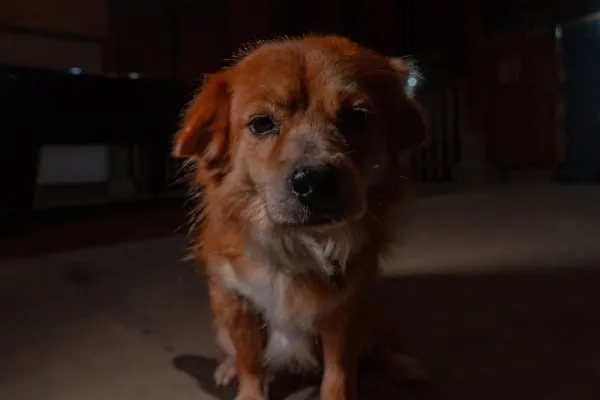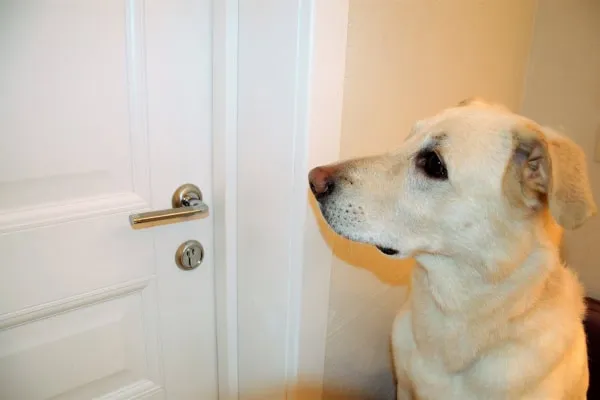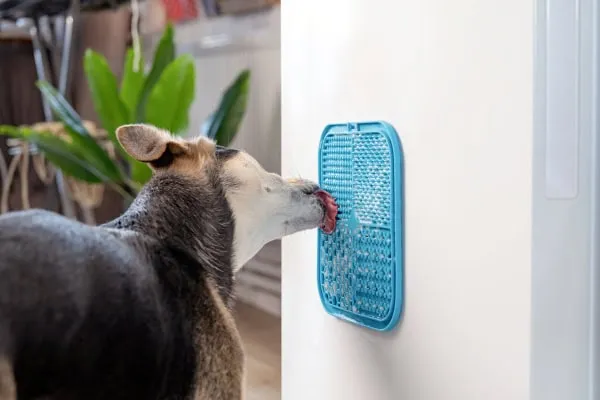When an older dog begins to exhibit signs like pacing, excessive barking, agitation, or destructive behaviors upon your departure, it’s often a clear indicator of Separation Anxiety In Old Dogs. Dr. Julie Buzby, an integrative veterinarian, delves into why senior canines may develop this condition and offers practical strategies to alleviate their distress. While separation anxiety is frequently associated with younger dogs, it can manifest at any age, making it crucial for owners of senior pets to recognize its triggers and symptoms.
What is Canine Separation Anxiety?
Separation anxiety is a behavioral disorder characterized by significant discomfort and distress when a dog’s primary attachment figure (human or animal) leaves the house or even just another room. Dogs suffering from this condition exhibit a spectrum of emotional and physical reactions when left alone, including incessant barking or whining, destructive chewing, house soiling, and attempts to escape. The intensity of these reactions can vary greatly among individual dogs and situations. While symptoms can emerge during puppyhood, they can also appear later in life, posing particular concerns for older dogs.
Why Do Older Dogs Develop Separation Anxiety?
If your senior dog, who previously tolerated your absence well, suddenly develops symptoms of separation anxiety, it often points to an underlying change in their health or environment. Several factors can contribute to the sudden onset of common behavior issues in dogs like separation anxiety in older canines.
Sensory Impairment: Deafness or Blindness
Dogs experiencing loss of hearing or vision may develop separation anxiety, especially during the initial stages of impairment. Without the ability to see or hear, they become more reliant on their pet parents for reassurance and guidance. Furthermore, deaf or blind dogs might not register when someone leaves a room or the home, leading to a sudden realization of their person’s absence that can amplify stress and anxiety.
 A senior dog with impaired vision, which can be a cause of separation anxiety
A senior dog with impaired vision, which can be a cause of separation anxiety
New Medical Conditions
Separation anxiety in old dogs can also be linked to new medical conditions. Just as humans find comfort in their pets when unwell, sick or injured dogs often feel more secure with their owners nearby. If your dog has recently developed a health issue causing discomfort, separation anxiety may arise as a consequence. For some, the anxiety may subside once the dog’s physical condition improves, but for others, it can become an ongoing issue.
Canine Cognitive Dysfunction (CCD)
In senior dogs not affected by deafness, blindness, or other medical issues, canine cognitive dysfunction (CCD), also known as doggy dementia, is a primary cause for sudden separation anxiety. Signs of dementia in dogs include changes in behavior such such as house accidents, forgetting commands, repetitive actions like walking in circles, altered sleep-wake cycles, and changes in interactions with family members and other pets. Dogs with CCD can become easily confused, disoriented, or lost, frequently leading to generalized anxiety, dog behaviorist near me for anxiety, noise phobias, or a combination of anxiety types.
Recognizing Symptoms of Separation Anxiety in Older Dogs
Older dogs exhibiting separation anxiety often display symptoms similar to those seen in younger dogs, though they may vary in severity. Key signs include:
- Appearing startled or worried when you exit a room.
- Frantically searching for you if they don’t immediately notice your departure from a room.
- Increased following of you around the home.
- Showing worry as you prepare to leave the house.
- Pacing, panting, trembling, or drooling that may begin even before you depart.
- Excessive vocalization (barking, howling, or whining) when left alone.
- Destructive behaviors when alone, such as chewing furniture, digging at floors, scratching windows, or attempting to escape crates or rooms.
- Urinary and stool accidents indoors, despite being house-trained.
- Vomiting or diarrhea due to stress.
- Refusal to eat or poor appetite.
- Developing compulsive licking disorder in dogs or other compulsive behaviors like circling or tail-chasing.
- Difficulty sleeping or increased restlessness.
Since separation anxiety in older dogs often stems from another condition, you might also observe additional symptoms related to the underlying trigger. Furthermore, symptoms can evolve over time, particularly in older dogs who may also be grappling with canine cognitive dysfunction.
Sundowning in Older Dogs
If your older dog’s separation anxiety is linked to canine cognitive dysfunction, you might notice that the anxiety intensifies at night. This phenomenon, known as “sundowning,” is a component of CCD where affected dogs become easily confused and disoriented after dusk. Even if you are present or in the same room, a sundowning dog may experience heightened anxiety and require extra reassurance during these hours.
 An older dog showing anxiety in a dimly lit room during the night
An older dog showing anxiety in a dimly lit room during the night
Nine Strategies to Help an Older Dog with Separation Anxiety
While managing separation anxiety in old dogs requires time, commitment, and patience, there are effective strategies to help your beloved companion. These nine tips can make the process smoother.
1. Consult Your Veterinarian First
Addressing common behavior problems in dogs like separation anxiety often begins with a consistent training approach. However, before initiating desensitization and counterconditioning, a thorough veterinary consultation is essential. Your vet can conduct a comprehensive examination, gather information about your dog’s symptoms, and recommend blood tests to detect any underlying medical conditions contributing to the anxiety. Identifying and treating these issues can significantly improve anxiety-related symptoms and enhance your dog’s overall health. Even if your dog receives a clean bill of health, your vet’s input is invaluable. Dogs with severe separation anxiety or CCD symptoms may benefit from medications to promote calmness and safety. Your veterinarian can help formulate a suitable medication protocol and offer additional at-home tips and tricks.
2. Desensitize Your Dog to Your Departures
One of the most effective ways to help your dog with separation anxiety is by desensitizing them to your leaving routine. This helps prevent the “ramp-up” of anxiety that typically starts as you prepare to depart.
Identify Anxiety Triggers
Dogs are incredibly astute observers of our cues and routines. While it might seem that your dog only gets anxious when you open the door, their anxiety is likely building much earlier—perhaps when you brush your teeth, get dressed, or put on your shoes. The first step is to pinpoint exactly when your dog starts to show signs of anxiety during your “getting ready” process.
Desensitize Each Step of the Routine
Next, gradually teach your dog that each step of your routine is not a reason to be anxious. For example, if putting on shoes is a trigger, wear your shoes around the house for several days, associating them with positive experiences like feeding time or playtime, rather than just with leaving. Similarly, if brushing your teeth is a trigger, brush your teeth and then engage in quality time with your dog, avoiding an immediate departure.
Once your dog remains calm throughout the “getting ready” process, it’s time to work on the actual act of leaving. Common triggers include picking up keys, starting the car remotely, or opening the door. Each of these steps that cause anxiety needs to be desensitized individually.
Training Calmness When the Door Opens
To train your dog not to react to the door opening, practice opening the door a few times a day. Reward your dog with treats, a favorite toy, or positive encouragement each time, but do not step outside.
 A dog calmly sitting by the door, receiving positive reinforcement
A dog calmly sitting by the door, receiving positive reinforcement
Gradually Extend Absence Duration
Once your dog is comfortable with the door opening, begin stepping outside and closing the door behind you for very short periods. You can talk to your dog through the door to reassure them. If possible, have someone inside to continue reassuring and rewarding your dog. Over time, slowly extend the duration of your absence. Start with 20 minutes, then gradually increase to an hour, then two, then four, and so on. This process should be gradual, spanning several days or weeks, to allow your dog to adjust and learn at their own pace.
Embrace the Process
Expect occasional setbacks and be patient. The goal is to reassure your dog and help them feel comfortable during your absence. This will require time and consistent repetition. Remember, this journey is about helping your beloved companion achieve peace of mind.
3. Create a Secure and Safe Space for Your Dog
Establishing a safe space for your dog to retreat to when you’re away is another crucial component of desensitization and anxiety reduction. This space could be:
- A designated special dog bed
- A quiet corner of a room
- A bathroom or another room where the door can be shut
- A crate
Finding the best option for your dog may involve some trial and error. Regardless of the chosen location, ensure it is comfortable and inviting. For older dogs with osteoarthritis, it’s particularly important that their safe space allows them to stand, turn around, and lie down with ease.
Stocking the Safe Place
If your dog doesn’t chew or shred bedding, an orthopedic bed or soft blanket can greatly enhance comfort and potentially decrease their anxiety. Depending on your dog’s habits, you might also include food and water.
Some dogs find background white noise, calming music, or a TV show soothing, while others find it stressful. Observe your dog closely to determine what type and level of sound is most beneficial.
Finally, a special food-stuffed toy or a safe chew toy for dogs can provide entertainment during your absence. Always ensure the toy is safe and won’t pose risks like intestinal blockages or choking. It’s advisable to supervise your dog with new toys before leaving them alone with them.
 A senior dog resting comfortably on a dog bed in their designated safe space
A senior dog resting comfortably on a dog bed in their designated safe space
4. Consider Crate Training (If Not Already Done)
For many cases of separation anxiety, crate training an older dog can be highly beneficial. A properly crate-trained dog often views their crate as a personal “mini home” and a place of security. If your dog exhibits destructive behavior or attempts to escape due to separation anxiety, a crate can be the safest place for them when you’re away. For dogs with canine cognitive dysfunction, a crate prevents them from getting lost or stuck in corners of the house.
5. Utilize Calming Pheromones
Calming pheromones offer another effective method to reduce anxiety and promote relaxation in dogs. Pheromones are natural chemical signals that dogs (and other animals) release to communicate. They play roles in identification, calming, and signaling stress. Calming pheromones, like those found in Adaptil®, convey comforting messages to your dog. Research, including a study on dog-appeasing pheromone (DAP) in hospitalized dogs, supports its effectiveness in reducing anxiety and related symptoms. DAP products are conveniently available as diffusers, sprays, and collars.
6. Improve Home Navigation for Your Dog
Sometimes, separation anxiety in old dogs develops because they become fearful of moving around the home alone, particularly if their vision is deteriorating, especially at night. A simple trick is to use night lights throughout your home, which can help your dog see more easily, especially if they have CCD and are prone to pacing.
Another helpful tip for homes with stairs is to place bright yellow duct tape on the edge of each step. As dogs age and their eyesight weakens, their depth perception often declines. The yellow or reflective tape helps them distinguish the beginning and end of each step.
For blind dogs, using distinct sounds, smells, and textures to mark various locations or objects in the home, and working with them to develop a mental map, can be incredibly beneficial. These steps are often part of how to care for a blind dog, but if not already implemented, they are worth trying.
7. Provide Comfort and Reassurance
Offering comfort and reassurance is vital, especially for dogs with dementia. Some CCD-affected dogs may wake up fearful that you’ve disappeared (even if you’re right next to them) or become startled and disoriented. During these moments, it’s crucial to comfort them and make your presence known through gentle petting and soft words.
An item of your clothing or a blanket that carries your scent can also provide an extra layer of comfort. Place it on their bed or favorite spot, or drape it over them while they sleep. This familiar scent can be reassuring even when you are nearby.
8. Manage Underlying Health Concerns
If an underlying medical condition is contributing to your my pitbull has separation anxiety, addressing it is paramount. This might involve collaborating with your vet to find the right combination of medications and natural pain relief options for dogs to manage discomfort. Or, it could mean treating conditions like diabetes or Cushing’s disease with appropriate medication.
For canine cognitive dysfunction, a multi-faceted approach is often most effective, combining strategies such as:
- Engaging your dog with mental stimulation toys and games.
- Maintaining a consistent daily routine.
- Administering medications like selegiline for dogs.
- Providing supplements that support cognitive function, such as organic MCT oil or melatonin for dogs (xylitol-free).
- Feeding a diet specifically formulated for CCD, such as Purina NeuroCare® or Hills b/d Brain Aging Care.
There is no one-size-fits-all solution, so the goal is to discover what works best for your individual dog.
 A dog engrossed in licking a lick mat, a form of mental stimulation
A dog engrossed in licking a lick mat, a form of mental stimulation
9. Discuss Anti-Anxiety Medications with Your Vet
If, despite implementing desensitization techniques and other tips, your dog’s separation anxiety shows no improvement or worsens, it’s time to consult your veterinarian about anti-anxiety medications. Medications such as trazodone for dogs can significantly lower anxiety levels, allowing other behavioral approaches to be more effective. Your vet can determine if your dog is a suitable candidate for medication and recommend the best option to try first.
Patience and Persistence: The Path to Peace
Navigating separation anxiety in your beloved senior dog, potentially compounded by CCD, blindness, or other conditions, can initially feel overwhelming. However, the strategies outlined here aim to make the journey smoother. Remember that patience, persistence, and some trial and error will be necessary to find what truly works for your dog. The ultimate goal is to help your companion feel less anxious during your absences. Do not hesitate to seek help; your veterinarian is an invaluable partner in managing your older dog’s separation anxiety.
